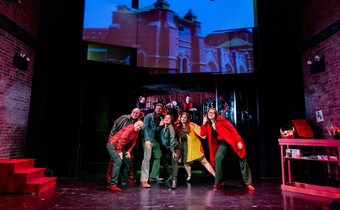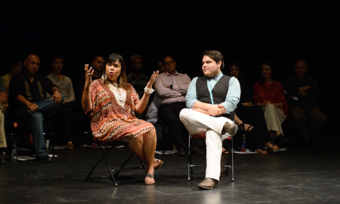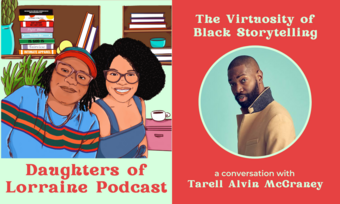A Family Affair
The Gifts of Jim Houghton
Jim Houghton greeted everyone who worked at Signature Theatre with a warm “Hey, brother!” or “Hey, sister!” The sibling designation wasn’t just rhetoric (nothing ever was with Jim). Signature’s playwrights are “in residence,” and everyone referred to the writers by their first name. It was always “Katori,” “Sam,” or “Martha,” never “Ms. Hall,” “Mr. Shepard” or “Ms. Clarke.” Even if you had never met them, they felt like part of the family. Signature feels like home. That’s true even for those who have left the nest. During the run of every production, Signature hosts an Alumni Night, a preview performance that is free for anyone who has ever worked there. They’re the best family reunions I’ve ever been to.

On August 2, 2016, Jim passed away all too soon at the age of 57, having led the company he founded for 25 years. He taught many who had the privilege of working with him how to say hello—the “Hey, brother” welcome was infectious—but I know I’m not the only one having a hard time saying goodbye.
After a stint as an intern in the fall of 2009, Signature hired me to work on the capital campaign to build what would become The Pershing Square Signature Center. My primary job was to tell the company’s story—who we were, why we were building not just a theatre but a complex, what we planned to do there—to anyone who was interested, especially prospective donors. Along the way, I learned countless lessons from Jim about being a producer, a leader, and a citizen.
‘We do relationships,’ he would say. ‘The plays are an outgrowth of those relationships.’ That outgrowth touched artists, staff, and audiences.
His commitment to Signature’s mission was marrow-deep, and he had a genius for imagining how it could inform every aspect of the organization. The mission statement is majestically simple: “Signature Theatre exists to honor and celebrate the playwright.” The mission had a centrifugal force that extended outwards and onwards. “To honor and celebrate” wasn’t just to produce, although that was part of it. It was about a long-term engagement with a body of work. “We do relationships,” he would say. “The plays are an outgrowth of those relationships.” That outgrowth touched artists, staff, and audiences.
If architecture is frozen music, then Jim was the maestro of the Center’s “orchestrated collisions,” his term of art for how people, plays, and ideas interact by virtue of their sheer proximity. The Center is a truly democratic space with no VIP lounge or even a stage door. You don’t have to buy anything to enter. He wanted people to hang out, run into old friends, and peruse what he half-jokingly claimed would be the last remaining bookstore in New York City.
Jim wanted everyone to come to the theatre. The Signature Ticket Initiative, which subsidizes every ticket during the regular run of every show, is the most magnanimous expression of that desire. For him, an affordable ticket was always an invitation. In a time when public space is shrinking and what’s left is being monetized, Jim threw open the doors of the Center and invited all of New York City to share space and stories. During the Center’s Ribbon Cutting Ceremony, architect Frank Gehry, who designed the Center, called Jim, “the biggest dreamer of them all.” I think it’s because his dreams were big enough for everyone to step inside them.
Jim had a gift for coming up with amazingly good ideas and doing the grueling work to convince people they were possible. Trust me when I tell you that Hercules had an easier time finishing his twelve labors than Jim did building and funding the Center. Many times, Executive Director Erika Mallin and I handed him the best weapons we could—a strong proposal, the right naming opportunity—to fend off the many-headed Hydra of deadlines and cash flow (or lack thereof) that threatened to swallow the campaign. Jim, in turn, would help me clean up whatever Augean stable I occasionally stepped in.
When I walked into work on the day the Center opened in January 2012, the box office did not exist. That afternoon, it appeared, and we were selling $25 tickets to three shows out of it the next morning. Somehow that magical experience, where the line between the possible and impossible blurs, encapsulates everything about my time at Signature and what I will miss about Jim.
I wish the description “inspiring,” weren’t so worn out, because Jim literalized it so well, breathing life into an idea. Chronicling all the ambitions and organizations that he helped give birth to—a family tree with him at the root—could fill a small book. A year into my tenure, I started a company with a coworker that was basically a low-budget imitation of Signature. My former colleague Talia Corren posted on Facebook recently that Jim gave her “a place at the table in a room full of very powerful people, and therefore the confidence to be there.” She’s now the founder and executive director of The Uprising, a nonprofit organization.
There was so much clarity about the mission of the theatre and each person’s contribution to it that nothing could break the ties that bound us together.
I don’t mean to say everything came up roses at Signature. Like all families, there were sibling rivalries and the occasional grudge match. But there was so much clarity about the mission and each person’s contribution to it that nothing could break the ties that bound us together.
I would be remiss if I didn’t also acknowledge Jim’s real family, his wife Joyce O’Connor, Signature’s first and fiercest champion, and his children, Lily and Henry, whose warmth is matched only by their parents’. It’s hard to articulate how important it was to see that Jim cared about his family so much. It encouraged you to love openly other things in life besides work and affirmed that it’s important to make time for those things.
When I learned that Jim had died, I had a vision that he reached Paradise when Romulus Linney, Horton Foote, Arthur Miller, Lanford Wilson, Leslie Lee, and August Wilson all greeted him with a big, “Hey, brother!” I know they missed him, because so many of us miss him already. I dream about meeting Jim again and seeing what he has built in the hereafter, because there is no place, above or below, that wouldn't be made better by the brilliance of his vision and tenderness of his heart.












Comments
The article is just the start of the conversation—we want to know what you think about this subject, too! HowlRound is a space for knowledge-sharing, and we welcome spirited, thoughtful, and on-topic dialogue. Find our full comments policy here
Signature Theatre is my favorite theater in New York City. I've seen three shows there which is a lot considering how rarely I can go to New York City and see a play. I especially like the book store in the lobby although I usually buy books at the Drama Book Shop since they have everything you could possibly want.